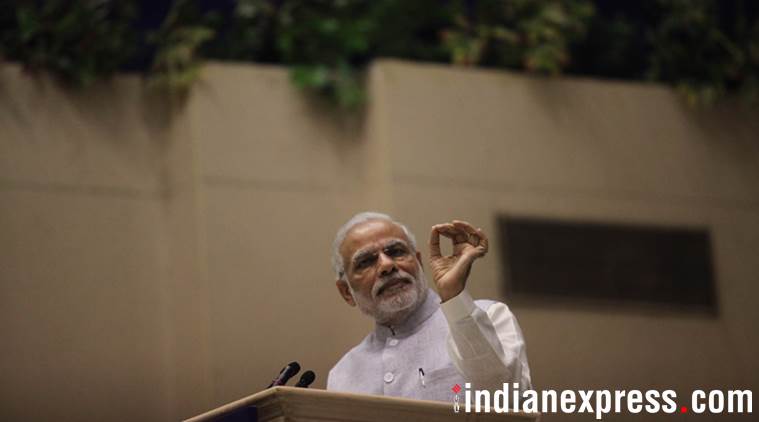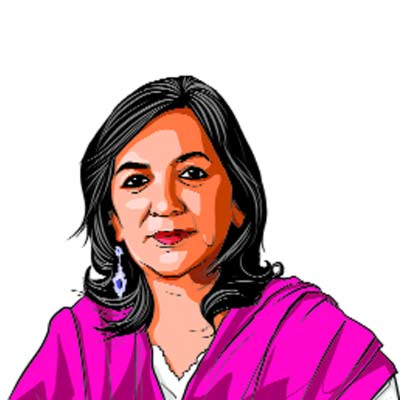 “Main poori sarkar ko apni hatheli main la sakta hoon. Ek bar governance mere palm par hai, sarkar mere haathon main hai. (Through the use of this app, all the information about this government I have in the palm of my hand. Once I have this information, I have the power over the government,” PM Modi said. (Expres Photo by Tashi Tobgyal)
“Main poori sarkar ko apni hatheli main la sakta hoon. Ek bar governance mere palm par hai, sarkar mere haathon main hai. (Through the use of this app, all the information about this government I have in the palm of my hand. Once I have this information, I have the power over the government,” PM Modi said. (Expres Photo by Tashi Tobgyal)
The NaMo phone App for the first time last week leveraged the miracles of technology to connect prime minister Narendra Modi to thousands of BJP ‘karyakartas’ across the country on the BJP’s 38th Foundation Day (Sthapna Divas) on April 6.
The PM’s enthusiasm for pushing the frontiers of people-friendly tech is well-known, so for 43 minutes and 14 seconds on that day, he sat in front of a camera, heard the phone ring, pressed a button that connected the call and answered questions from five parliamentary constituencies across the country. He had announced earlier that he would speak to karyakartas of constituencies whose MPs had more than 3 lakh followers on Twitter.
Surprisingly, though, the tech-friendly PM’s team is slipping up. Key highlights from Modiji’s telephone call to karyakartas were uploaded on Twitter only the day after, on April 7. Perhaps the team were busy with dealing with the aftermath of the controversy initiated by I&B minister Smriti Irani and forming a new committee which will deal with social media – MyGov CEO Arvind Gupta, who is also part of this committee, is also ultimately responsible for the PM as well as the government’s presence on social media.
The PM’s order to rollback the I&B directive has been much in the news all week, even though none of his social media handles mention anything. In his call to the karyakartas that came soon after, the PM only took the names of two people in the BJP — former PM Atal Behari Vajpayee and New Delhi MP Meenakshi Lekhi, from whose constituency one karyakarta was picked to speak to the PM – making people in the party sit up and pay attention.
The PM quoted Vajpayee’s eloquent slogan, “andhkaar chhatega, suraj niklega, kamal khilega (the darkness will disperse, the sun will rise and the lotus will bloom)” as proof of the BJP’s rise and rise in national politics.
“The BJP was born under very difficult circumstances in 1980. All political parties got together and declared it untouchable. The Janata Party had us thrown out. But today, where are those who declared us untouchable and where is the BJP? Today, the lotus is blooming everywhere,” the PM said.
There were three major messages from the phone call. First, that the BJP could not be blamed for the washout in Parliament (the Lok Sabha has lost 115 hours and the Rajya Sabha 111 hours, with Rs 169.5 crores lost on the wasted sessions), that it was the Opposition “which cannot tolerate that a poor woman’s son can become the PM.” Specifically, it is the Congress party which keeps repeating lies, even though the NDA and BJP keep winning elections, he said. All the Congress party can think of is to remove Modi by any means and grab the chair. “Jhoot par jhoot, jhoot par jhoot. Aur NDA ki jeet par jeet, jeet par jeet,” the PM added.
Second, as he watched the Dalit protests against the Supreme Court judgement breaking out last week, the PM defended his government’s efforts in uplifting people from the SC & ST communities. Like making tribal leader Karia Munda and Haryana Dalit leader Suraj Bhan deputy Speakers. “Yeh inko pach nahin raha hai (the Opposition cannot tolerate this),” he said.
Mamata Kumari from Mukherjee Nagar in Delhi asked how the PM controls his temper in the face of abuses and insults, as he and the BJP government were doing so much work. “Mamata ji, Namaste,” said the PM. Clearly, he retains the personal touch. Clearly, that’s what this whole exercise is about. He then went on to give Mamata ji, and all those listening in, in Karnataka for example, a most important lesson in How to Win An Election: “The key mantra is to win the polling booth. If we win the polling booth, we win. The critical thing is to have a good team of karyakartas at the polling booth, who should remain closely involved with the people at large. The karyakartas play a critical role. “Neechay se oopar jaankari detay hain aur oopar se neechay marg-darshan milta hai. (They give information from the ground and get guidance from the top). This is crucial because on the basis of this information, policy and strategy is formulated,” he said.
His third message, in response to Reshma from Mumbai who wanted to know about the benefits of technology, is revealing, especially in the light of the Cambridge Analytica controversy. “Technology is a huge tool to communicate and influence people. But if we are not careful, then those who spread rumours will capture the roots (of this technology). In this age of communication, if we are not careful, those who are greedy will fill that space. It is our responsibility not to leave any space unfilled, so as not to allow it to go into the wrong hands,” he said.
For example, the PM said, if you download the BHIM App, you will realise that the mobile phone isn’t just an instrument through which you can speak or listen to someone else speak.
“Main poori sarkar ko apni hatheli main la sakta hoon. Ek bar governance mere palm par hai, sarkar mere haathon main hai. (Through the use of this app, all the information about this government I have in the palm of my hand. Once I have this information, I have the power over the government,” the PM added.
We have to communicate the good work the government does. For eg, old age pension, widow pension, or the benefits from MNREGA. Through GeM (Government e-Marketplace, an end-to-end online marketplace) and the NaMo App, people will get the right information so at challenge disinformation, the PM added.
- If China builds your dams, India won’t buy energy: PM Narendra Modi to tell KP Oli
One particular dam project, the $2.5-billion Budhi Gandaki project, on a river by the same name in central-western Nepal, is increasingly becoming the centrepiece of…
- Soft hands and hard bargaining: What to watch in Modi-Oli meeting
Nepal PM in India: On Saturday, after their talks in Hyderabad House, KP Sharma Oli and Narendra Modi will push a button to virtually lay…
- Winning the neighbourhood
New Delhi seems to have realised its mistakes in dealing with its neighbours. It is willing to sweat behind the scenes to gain ground ceded…
